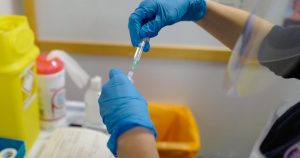The availability of intensive care beds in Southern California and the Central Valley hit alarming new lows as hospitals continued to see an influx of new COVID-19 patients in a surge that shows no signs of slowing.
“Like a speeding car approaching a cliff, if we do not rapidly change course, we are in jeopardy of catastrophic consequences,” Dr. Paul Simon, chief science officer for the Los Angeles County Department of Public Health, said during a briefing Thursday.
In Southern California, ICU availability fell to 7.7% on Thursday, down from 9% the day before, the latest data show. The state defines the region as Imperial, Inyo, Los Angeles, Mono, Orange, Riverside, San Bernardino, San Diego, San Luis Obispo, Santa Barbara and Ventura counties.
The situation was even more dire in the San Joaquin Valley region, which is reporting 1.9% availability, down from 4.2%.
Numbers have also worsened in the Greater Sacramento area, which reported in at 13.3%, down from 14.3%; and the San Francisco Bay Area, which was at 17.8%, down from 20.9%.
Rural Northern California remains in comparatively solid shape, at 30.3% availability.
Statewide, an all-time high of 11,497 coronavirus-positive patients were hospitalized as of Wednesday, the most recent day for which complete data are available.
That number increased by 485 in just one day and has swelled by 30% over the last week, state figures show.
The story is much the same when it comes to ICUs. The number of Californians requiring that level of care jumped 115 in just one day to a record 2,621 as of Wednesday.
As of Wednesday, L.A. County had 3,624 people in its hospitals with coronavirus infections, the 11th consecutive day that number has been a new high. The county’s net number of COVID-19 hospitalizations increased overnight between Tuesday and Wednesday by 191 — the highest single-day jump in the pandemic.
San Bernardino and Orange counties are the only others that have more than 1,000 coronavirus-positive patients, according to state data.
Hospitals can take steps to gird themselves against an influx of new patients — by canceling scheduled surgeries and outpatient visits; discharging patients as quickly as possible; and temporarily diverting ambulances with certain types of patients, for instance.
But ICU beds require high-tech equipment and specially trained healthcare professionals, which are in high demand throughout the state and nation.
Healthcare systems can move trained staff around to help plug gaps where needed, but “at a certain point, you run out of options, and that’s what we’re worried about,” Simon said.
“The worst-case scenario is what we saw back in the spring in New York City and in northern Italy where there were literally people in gurneys in hallways that were dying or near death, and that’s beyond a tragedy,” he said. “It’s just something that we can’t let happen. We have to do everything possible to prevent that.”
The way the state calculates regional ICU capacity is more complicated “than just looking at how many beds are full at any given point in time,” said L.A. County Public Health Director Barbara Ferrer.
She said Wednesday that the state had set a threshold that only 30% of ICU beds should be occupied by COVID-19 patients and that, should an area exceed that, “they make a downward adjustment — sort of, you get a penalty.”
The California Department of Public Health did not immediately respond Thursday when asked for the rationale behind the adjustment or how different regions’ numbers are affected.
However, as Simon pointed out: “We need ICU beds for other reasons. In this COVID pandemic, we’re not seeing heart attacks and strokes and other very severe illnesses disappear.”
According to data provided by Los Angeles County, 47% of the region’s intensive care beds were filled with COVID-19 patients as of Tuesday. That’s a significant cause for alarm, officials said.
“We’re always going to need ICU beds for those many other conditions and so there is greater concern if, in addition to seeing a reduced overall capacity, we’re seeing a greater proportion of these ICU beds taken up by COVID-19 patients,” Simon said.
How California determines ICU availability is of keen interest, as that’s the metric the state uses to determine whether to hand down additional restrictions on businesses and activities.
The state is implementing new stay-at-home orders in any region that sees its ICU capacity drop below 15%.
Those orders — which reduce capacity at retail stores; close businesses including hair salons, nail salons, card rooms, museums, zoos and aquariums; and prohibit outdoor restaurant dining — are already in place in Southern California and the San Joaquin Valley.
Those restrictions will also go into effect in Greater Sacramento beginning Thursday night.
Officials have said they hope the additional restrictions will help stymie the latest coronavirus surge.
California as a whole has averaged nearly 27,000 new coronavirus cases a day over the last week, a new record.
More Californians are also dying of COVID-19 than at any other point in the pandemic. The state has averaged 146 deaths a day over the last week — breaking an all-time record set in August.
L.A. County is now averaging more than 8,700 new coronavirus cases a day over the last week, the worst such average on record for the entire pandemic. The county is also averaging 48 COVID-19 deaths a day over the last week, close to the all-time record, which was 50 deaths a day in late April.
Given how widespread the virus is in communities up and down the state, experts say the best thing residents can do to keep themselves and their loved ones from being infected is to stay home as much as possible over the next few weeks.
“To be blunt, we have one chance to turn this serious surge around, and that chance is right now,” San Francisco health director Dr. Grant Colfax said this week. “But our window is narrowing and closing fast.”

















